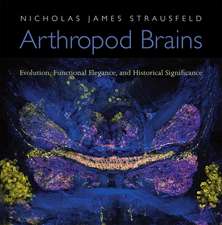Biology of the Arthropod Cuticle: Zoophysiology, cartea 4/5
Autor A. C. Nevilleen Limba Engleză Paperback – 15 dec 2011
Din seria Zoophysiology
- 15%
 Preț: 647.92 lei
Preț: 647.92 lei - 15%
 Preț: 638.76 lei
Preț: 638.76 lei - 15%
 Preț: 638.24 lei
Preț: 638.24 lei - 15%
 Preț: 641.38 lei
Preț: 641.38 lei - 15%
 Preț: 634.82 lei
Preț: 634.82 lei -
 Preț: 386.61 lei
Preț: 386.61 lei - 15%
 Preț: 636.94 lei
Preț: 636.94 lei - 15%
 Preț: 640.88 lei
Preț: 640.88 lei - 15%
 Preț: 635.47 lei
Preț: 635.47 lei - 15%
 Preț: 637.78 lei
Preț: 637.78 lei - 15%
 Preț: 640.88 lei
Preț: 640.88 lei -
 Preț: 386.61 lei
Preț: 386.61 lei - 15%
 Preț: 637.78 lei
Preț: 637.78 lei - 15%
 Preț: 638.24 lei
Preț: 638.24 lei - 15%
 Preț: 642.83 lei
Preț: 642.83 lei - 15%
 Preț: 634.68 lei
Preț: 634.68 lei - 15%
 Preț: 642.83 lei
Preț: 642.83 lei - 18%
 Preț: 999.60 lei
Preț: 999.60 lei - 15%
 Preț: 639.41 lei
Preț: 639.41 lei - 15%
 Preț: 638.43 lei
Preț: 638.43 lei - 15%
 Preț: 651.34 lei
Preț: 651.34 lei - 15%
 Preț: 638.57 lei
Preț: 638.57 lei - 15%
 Preț: 637.46 lei
Preț: 637.46 lei - 15%
 Preț: 637.59 lei
Preț: 637.59 lei - 15%
 Preț: 641.53 lei
Preț: 641.53 lei - 15%
 Preț: 636.80 lei
Preț: 636.80 lei -
 Preț: 386.22 lei
Preț: 386.22 lei - 15%
 Preț: 632.55 lei
Preț: 632.55 lei - 15%
 Preț: 695.19 lei
Preț: 695.19 lei -
 Preț: 401.24 lei
Preț: 401.24 lei - 18%
 Preț: 942.01 lei
Preț: 942.01 lei - 18%
 Preț: 945.30 lei
Preț: 945.30 lei - 15%
 Preț: 632.70 lei
Preț: 632.70 lei - 15%
 Preț: 640.71 lei
Preț: 640.71 lei - 15%
 Preț: 644.30 lei
Preț: 644.30 lei - 15%
 Preț: 642.68 lei
Preț: 642.68 lei
Preț: 652.17 lei
Preț vechi: 767.26 lei
-15% Nou
Puncte Express: 978
Preț estimativ în valută:
124.79€ • 130.29$ • 103.28£
124.79€ • 130.29$ • 103.28£
Carte tipărită la comandă
Livrare economică 04-18 aprilie
Preluare comenzi: 021 569.72.76
Specificații
ISBN-13: 9783642809125
ISBN-10: 364280912X
Pagini: 472
Ilustrații: XVI, 450 p.
Dimensiuni: 170 x 244 x 25 mm
Greutate: 0.74 kg
Ediția:Softcover reprint of the original 1st ed. 1975
Editura: Springer Berlin, Heidelberg
Colecția Springer
Seria Zoophysiology
Locul publicării:Berlin, Heidelberg, Germany
ISBN-10: 364280912X
Pagini: 472
Ilustrații: XVI, 450 p.
Dimensiuni: 170 x 244 x 25 mm
Greutate: 0.74 kg
Ediția:Softcover reprint of the original 1st ed. 1975
Editura: Springer Berlin, Heidelberg
Colecția Springer
Seria Zoophysiology
Locul publicării:Berlin, Heidelberg, Germany
Public țintă
ResearchCuprins
1 Introduction.- A. Treatment of Subject.- B. General Functions and Significance of Cuticle.- C. Previous Reviews.- 2 General Structure of Integument.- A. Basic Plan of Cuticle.- B. Epicuticle.- C. Procuticle.- D. Cellular Aspects.- E. Cuticle and Respiration.- F. Related Structures.- 3 The Structural Macromolecules.- A. Chitin.- B. Lipids.- C. Proteins.- D. Pterines.- E. Melanin.- F. Chemical Interactions in Cuticle.- 4 Molecular Cross-Linking.- A. Introduction.- B. Oothecal Protein Cross-Linking.- C. Tanning of Exocuticle.- D. Cross-Links in Endocuticle.- E. Autotanning.- F. Epicuticle Tanning.- G. Chitin-Protein Cross-Links.- H. Cross-Linking of Resilin.- I. Silk Tanning.- J. Stabilization of Egg Shells.- 5 Supermolecular Architecture.- A. The Microfibril in Cuticle.- B. Helicoidal Architecture.- C. Symmetry and Asymmetry of Microfibrillar Architecture.- D. Polymer Single Crystals.- E. Self-Assembly.- F. Is Cuticle Self-Assembled?.- G. Sense of Rotation of Helicoid.- H. Helicoidal Optics.- I. Crystallographic Faults in Cuticle.- J. Primary Versus Secondary Microfibril Orientation.- 6 Physiological Aspects.- A. Daily Growth Layers in Cuticle.- B. Hormones and Cuticle.- C. Wound Repair.- D. Contractile Filaments in Epidermis.- E. Nervous Control.- F. The Integument and Water Relations.- G. Control of Chitin Orientation.- 7 Calcification.- A. Cuticle Ultrastructure in Crustacea.- B. Calcification in Crustacea.- C. Calcium Storage in Crustacea.- D. Calcification in Insects.- 8 Physical Properties.- A. Optical Properties.- B. Cuticle and Sense Organs.- C. Electrical Properties of Cuticle.- D. Mechanical Properties.- E. Aspects of Cuticle Penetration.- 9 Phylogenetical Aspects.- A. Ecdysis.- B. Resilin.- C. Cuticle Architecture.- D. Fossil Cuticle.- E. Cuticle Studies on Arthropod Groups.- 10 Outstanding Problems.- A. Tricks and Techniques.- B. Tissue Culture.- C. Immunology.- D. Some Physical Methods.- E. Ultrastructural and Functional Problems.- F. Developmental Problems.- G. Chemical Problems.- H. Mechanical Problems.- I. Ecological Problems.- References.- Species Index.













